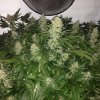The plants stores it's nutrients down in the root system at night and then starts moving it up the plant what's lights trn on "photosynthesis" if your plant is let's say 64 day flowerer in optimal conditions .. on day 50 if you are feeding at 2.0 ec for example start gradually lowering the ec over the two weeks on the day before harvest I'm at 0.5 -0.4 ec but I am not flushing the medium thosee 2 later week are critical for weight and bud maturity nurture the Damn thing.. then like I said persay a 64 day flower once u reach day 60 start checking those thrichromes all over the plant not just in one area and when u are going to harvest chop her down before lights on so it doesn't start photosynthesising ... honestly flushing at end of flowering is pointless keep a proper ph and a gradual increase on e.c don't over do fert and ull never have a problem withsalt buildup in your medium and that in my opinion is the only reason you should flush
What is happening in the plant during the last two weeks of growth? When I check... I see lots of different names for this period - aggressive bloom, bud swell, and etc. But no matter what it is called, this is a critical period in the development of an MJ plant. Smells develop and mature. Buds are filling with resin. And the plant is undergoing one final major push to produce. So the plant is growing in many ways, just not in physical size.
Why would anyone take away nutrients when the plant most needs them? Doesn't make sense. Ok... I know the argument, the plant is merely moving nutrients from one part to the other. Good argument, but unfortunately it just isn't true in all cases.
For our purposes, there are two classes of nutrients. Mobile nutrients and immobile nutrients. Mobile nutrients are ones that we know the plant can move around inside of itself. The immobile nutrients can only come from the roots - they can not be moved once inside the plant. There are scientific reasons behind this having to do with xylem and phloem that I will skip. If you are interested in the science behind this, let me know and I can give you some pointers.
So which are mobile nutrients? The list is as follows: N, P, K, Mg and S. The other nutrients which are immobile are Ca, Fe, Zn, Mo, B, Cu, and Mn. If you need a layman's thought process to justify this - the mobile nutrients are the ones that cause problems on older growth (they are stolen from old growth to support new growth... thus they are obviously mobile within the plant). The immobile nutrients affect the whole plant at once - and most especially in the areas of growth (the growth shoots or apical meristems) which is at the outside edges of the plant.
The typical recommendation for flushing goes something like this: "For the last two weeks of the flowering cycle, remove all nutrients and use R/O water." Some will suggest a flushing solution which is mostly sugar. In either case, you are severely limiting all nutrients - not just the mobile ones.
So why is this a critical error?
You need to think about what happens when a plant does not have calcium... cell division comes to a halt. This results in "stunted" growth if it occurs during the normal plants life cycle... something we would fight agressively... but we accept it as part of the final flush? Doesn't make sense.
Boron is also essential for new plant growth. Without Boron - you won't get good bud development.
I could go on and point out what each of these immobile nutrients do. But it would be better for you to go and find a source, read about the effects each of these nutrients has, and then decide if that is something that you want stopped during the last two weeks of flower.
The final thing I want to point out is plant stress. You are going from a high nutrient environment to one where you have pretty close to zero. This will obviously put stress on the plant. Think how long it would take for your body to adjust between say... a high fat diet and one based on water. You are not just going to continue in life like nothing happened... The same sort of thing happens to the plant. And plant stress reduces yield.
So I think that I have made my point that flushing is bad due to the science behind growth. But what does actual growing experience tell me?
It is a fact that flushing restricts yield. Don't care the type of MJ plant. I started with two week flushes... then moved to one week to limit the amount of yield loss... and have now moved to 3 days on my latest grow. I can't tell any difference in taste between each of these time frames. And yes, I have had overlapping yields of the same plants genetics - so that I can actually tell.
That's not mine btw but very explanatory




